Ministry of Information & Broadcasting
100 days of Modi 3.0: Governance with Citizen First Approach
Posted On: 25 SEP 2024 1:45PM
Introduction
Good governance is essential for a nation's development. To build a strong foundation for a prosperous India, various initiatives have been launched under the Viksit Bharat 2024 vision. Key reforms have been introduced to drive India's progress and promote transparency. A holistic, 360-degree approach has been adopted, focusing on social, economic, and judicial empowerment. Notable measures include the launch of three New Criminal Laws and the National Forensic Infrastructure Enhancement Scheme (NFIES) for scientific evidence processing. Other important initiatives include Pension Reforms, Review of Income-Tax Act and the Appointment of over 15,000 youth for government jobs etc.
Launch of Three New Criminal Laws
Three new criminal laws came into effect on July 1, 2024, replacing colonial-era legislation with a focus on justice over punishment, ensuring speedy trials and timely justice. New laws are justice-oriented and victim-centric. These laws prioritize crimes against women and children, introducing a dedicated chapter to address these issues more sensitively. Victims' rights are also strengthened under the new legal framework. Additionally, the laws are designed to integrate and adapt to evolving technology, ensuring they remain relevant for the next 50 years.
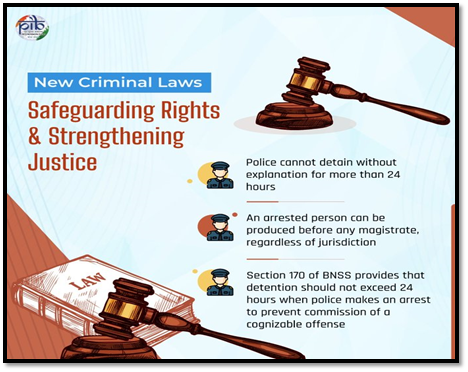
Union Home Minister and Minister of Cooperation, Shri Amit Shah also launched e-Sakshya, Nyaya Setu, Nyaya Shruti and e-Summon App for three new criminal laws. e-Sakshya, e-Summon, Nyaya Setu and Nyaya Shruti apps will strengthen the technical competency of the entire system. Under e-Sakshya, videography, photography and testimonies will be saved on the e-evidence server, which will also be available in the courts immediately. Under the e-Summon, it will be sent electronically from the court to the police station and also to the person to whom the summons is to be sent. Police, Medical, Forensic, Prosecution and Prisons are interlinked together on the Nyaay Setu Dashboard, which will provide the police with all the information related to the investigation in just one click. Through Nyaay Shruti, the court will be able to hear witnesses through video conferencing. This will save time and money and also settle the cases faster.
National Forensic Infrastructure Enhancement Scheme (NFIES)
The Union Cabinet, led by Prime Minister Shri Narendra Modi, has approved the Ministry of Home Affairs' proposal for the Central Sector Scheme "National Forensic Infrastructure Enhancement Scheme" (NFIES) with a total financial allocation of ₹2,254.43 crore, covering the period from 2024-25 to 2028-29.
The Cabinet has approved the following components under this Scheme:
i. Establishment of campuses of the National Forensic Sciences University (NFSU) in the country.
ii. Establishment of Central Forensic Science Laboratories in the country.
iii. Enhancement of existing infrastructure of the Delhi Campus of the NFSU.
Public Examinations (Prevention of Unfair Means) Act implemented
The Public Examinations (Prevention of Unfair Means) Act, 2024 came into effect on June 21, 2024, aiming to curb unfair practices and organized malpractices in public examinations. The law ensures the integrity of exams by preventing leaks and other misconduct, protecting the merit of students and job seekers. This legislation plays a vital role in safeguarding youth interests and promoting fairness in recruitment and academic assessments conducted by bodies like the National Testing Agency (NTA).
Purvodaya Plan
The Purvodaya initiative is a transformative plan aimed at the all-round development of the eastern region of India, encompassing Bihar, Jharkhand, West Bengal, Odisha, and Andhra Pradesh. This comprehensive strategy focuses on human resource development, infrastructure enhancement, and economic opportunities to propel the region towards becoming a key driver of Viksit Bharat (Developed India).
Key aspects of Purvodaya include:
- The development of the Amritsar-Kolkata Industrial Corridor includes a key industrial hub at Gaya.
- The plan also emphasizes crucial road connectivity projects such as the Patna-Purnea Expressway, Buxar-Bhagalpur Expressway, and spurs to Bodhgaya, Rajgir, Vaishali, and Darbhanga, along with a new 2-lane bridge over the Ganga River at Buxar.
- Purvodaya also addresses Andhra Pradesh’s development under the Andhra Pradesh Reorganization Act, with funding for infrastructure projects like water, power, railways, and roads in the Kopparthy node on the Vishakhapatnam-Chennai Industrial Corridor and Orvakal node on the Hyderabad-Bengaluru Industrial Corridor.
- The Polavaram Irrigation Project, vital to Andhra Pradesh, will be prioritized to ensure farmers' welfare and enhance food security.
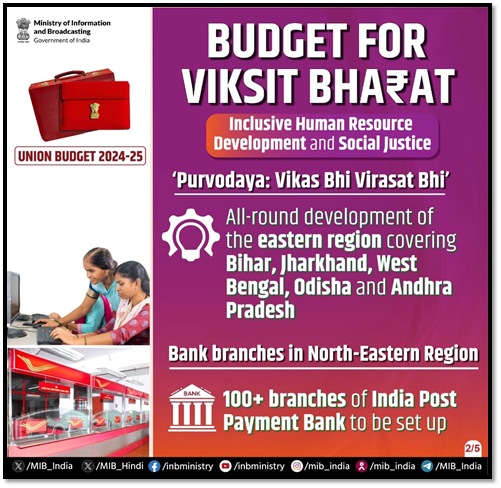
Five new districts approved in Ladakh
In a landmark decision, the Ministry of Home Affairs has approved the formation of five new districts in the Union Territory of Ladakh: Zanskar, Drass, Sham, Nubra, and Changthang on 26th August, 2024. With this addition, Ladakh now has seven districts, including Leh and Kargil. This strategic initiative is designed to promote the region’s overall development, enhance access to public welfare schemes, and enable more effective and localized governance for Ladakh's residents.
Ladakh, one of India's largest Union Territories by area, is also among the least populated regions in the country. Due to its challenging terrain and inaccessibility, the district administration has faced significant difficulties in reaching the grassroots level. However, with the creation of new districts, public welfare schemes from both the Central Government and Ladakh Administration will now be able to reach the people more effectively, allowing a greater number of residents to benefit. This key decision by the Ministry of Home Affairs (MHA) will play a vital role in promoting the overall development of Ladakh.
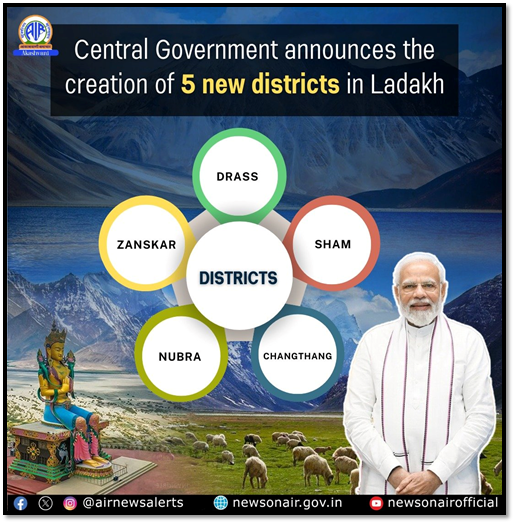
Announcement of 'Samvidhaan Hatya Diwas'
The Government of India has decided to observe 25th June every year as 'Samvidhaan Hatya Diwas.' This day will commemorate the massive contributions of all those who endured the inhuman pains of the 1975 Emergency.
Two Geoportals launched
Union Minister Dr. Jitendra Singh on 28th June, 2024 launched two Geoportals namely ‘Bhuvan Panchayat (Ver. 4.0)" portal for rural land record and "National Database for Emergency Management (NDEM Ver. 5.0)" developed by Indian Space research Organization (ISRO) at Prithvi Bhavan. Latest geospatial tools are meant for visualisation and planning to provide high resolution satellite imagery of 1:10K scale for different locations across the country.


Comprehensive Review of Income-Tax Act
During 2024-25 Budget speech, the Finance Minister announced a comprehensive review of the Income-tax Act, 1961, aimed at making the Act more concise, clear, and easier to understand. She further stated that the review would be completed within six months. In line with this commitment, the task has been undertaken with great diligence. An internal committee has been formed, led by a serving Chief Commissioner of Income Tax, and includes officers from various regions and divisions of the Income Tax Department nationwide.
The Committee has been mandated to:
- Carry out a comprehensive review of the Act.
- Identify the redundant provisions/sections in the Act.
- Identify & suggest changes for simplification of the Act to make it concise, lucid & easy to read and understand so as to reduce litigation, provide certainty to taxpayers & bring down the demand involved.
- The Committee may also undertake stakeholder consultations in due course.
- The Committee is mandated to complete the work within the stipulated time.
50% pension assured to 23 lakh central government employees
Cabinet has approved introduction of Unified Pension Scheme (UPS) on August 24, 2024 to improve the National Pension System (NPS) for Central Government employees. This will ensure to Government employees certainty in their pension, in particular assurances regarding pension, family pension, minimum pension and inflation indexation.
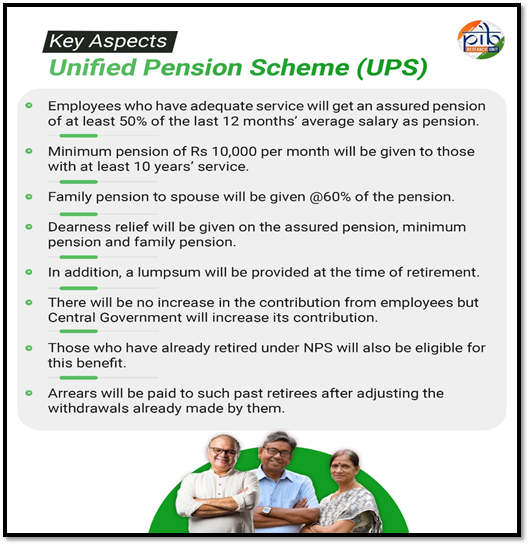
Main Highlights & Facts
- The employee contribution shall remain un-altered at 10% of (basic pay + DA).
- The Government contribution will increase from the present 14% to 18.5%.
- The pension corpus will be divided into two funds:
- An individual pension fund to which the employee contribution (10@% of basic pay and DA) and matching Government contribution will be credited.
- A separate pool corpus with additional Government contribution alone (8.5% of basic and DA of all employees).
- The employee can exercise an investment choice for the individual pension corpus alone.
- Assured pension will be based on the ‘default mode’ of investment pattern notified by PFRDA and considering full annuitization of individual pension corpus.
- Full assured pension will be available for a minimum qualifying service of 25 years. For lesser service, starting from at least 10 years, pro rata assured pension will be given.
- Employees would have a choice to opt for UPS. An employee could choose to continue with the NPS, if s/he so desires.
- The UPS will be given effect from 01.04.2025.
- The scheme can also be adopted by State Governments. This is expected to benefit over 90 lakh employees (23 lakh Central Government employees, 3 lakh employees of Central Autonomous Bodies and another 56 lakh employees of State Governments and 10 lakh employees of State Autonomous Bodies, if adopted by the State Governments).
Revision of One Rank One Pension (OROP) Scheme
The One Rank One Pension (OROP) scheme ensures equal pensions for Armed Forces personnel of the same rank and service length, irrespective of their retirement date. The Union Cabinet approved the latest revision, effective from July 1, 2019, which adjusts pensions based on the average of minimum and maximum pensions from 2018. This revision benefits over 25 lakh retired personnel and their families. The scheme carries significant financial implications, with substantial arrears and an estimated annual cost of around ₹8,450 crore.
Facts
- Long Pending demand of veterans fulfilled in 2015.
- Uniform pension to personnel retiring in same rank with same length of service, regardless of retirement date.
- Over 25 lakh Armed Forces Pensioners/family pensioners benefitted and Rs 93,000 crore spent in last nine years.
- Second revision of OROP issued in January 2023. Personnel retired up to June 30, 2019 now covered under OROP.
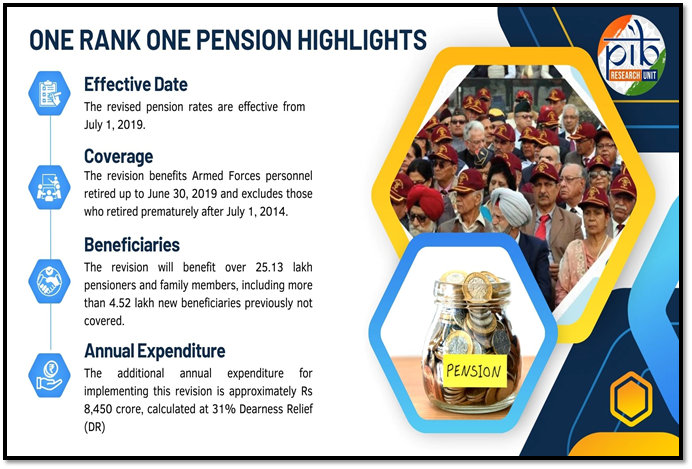
To further enhance efficiency, additional initiatives were introduced, including the issuance of appointment letters to over 15,000 youth for government jobs.
Conclusion
These initiatives demonstrate a comprehensive approach to social welfare, transparency, and economic advancement. Through targeted programs like OROP, UPS, and the Purvodaya Plan, the government is working to close socio-economic gaps and uplift those in need. While challenges persist, these efforts are vital in building an inclusive society where everyone has the chance to succeed. Sustained focus and innovation in these initiatives will be key to creating lasting impact and ensuring that the benefits of progress reach all parts of the nation.
Reference
Kindly find the pdf file
*****
Santosh Kumar/ Sarla Meena/ Kamna Lakaria
(Backgrounder ID: 153202)
Visitor Counter : 15